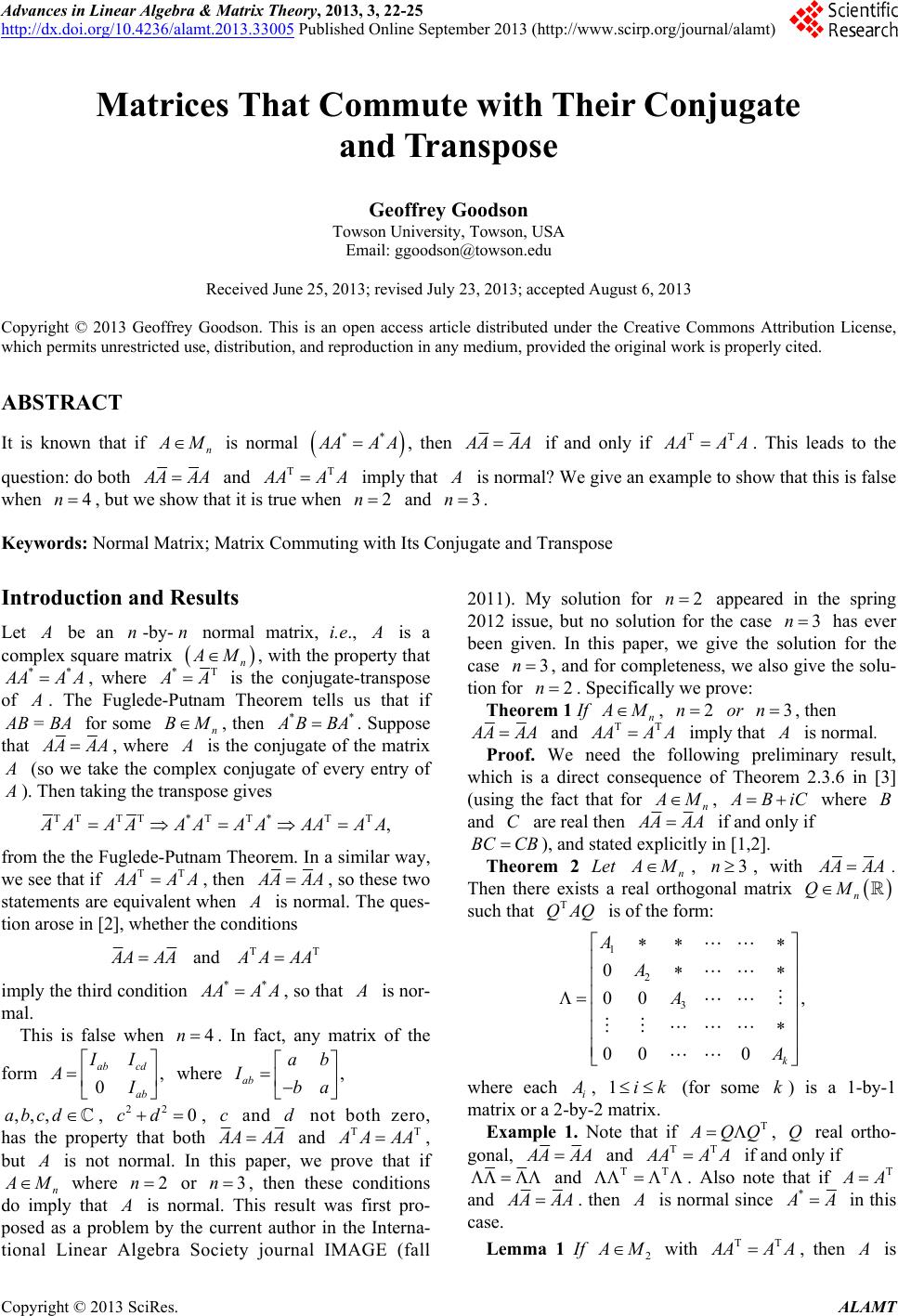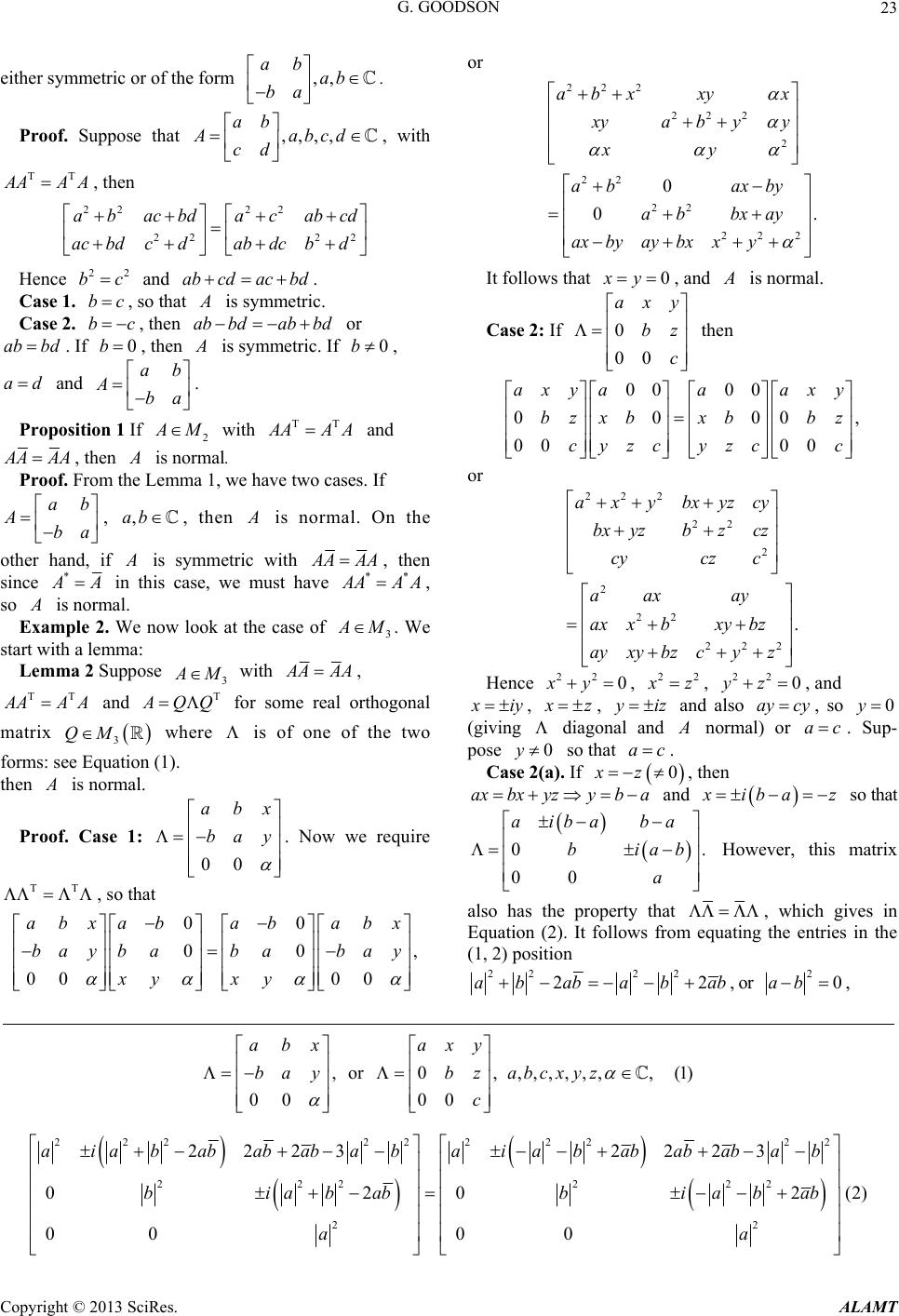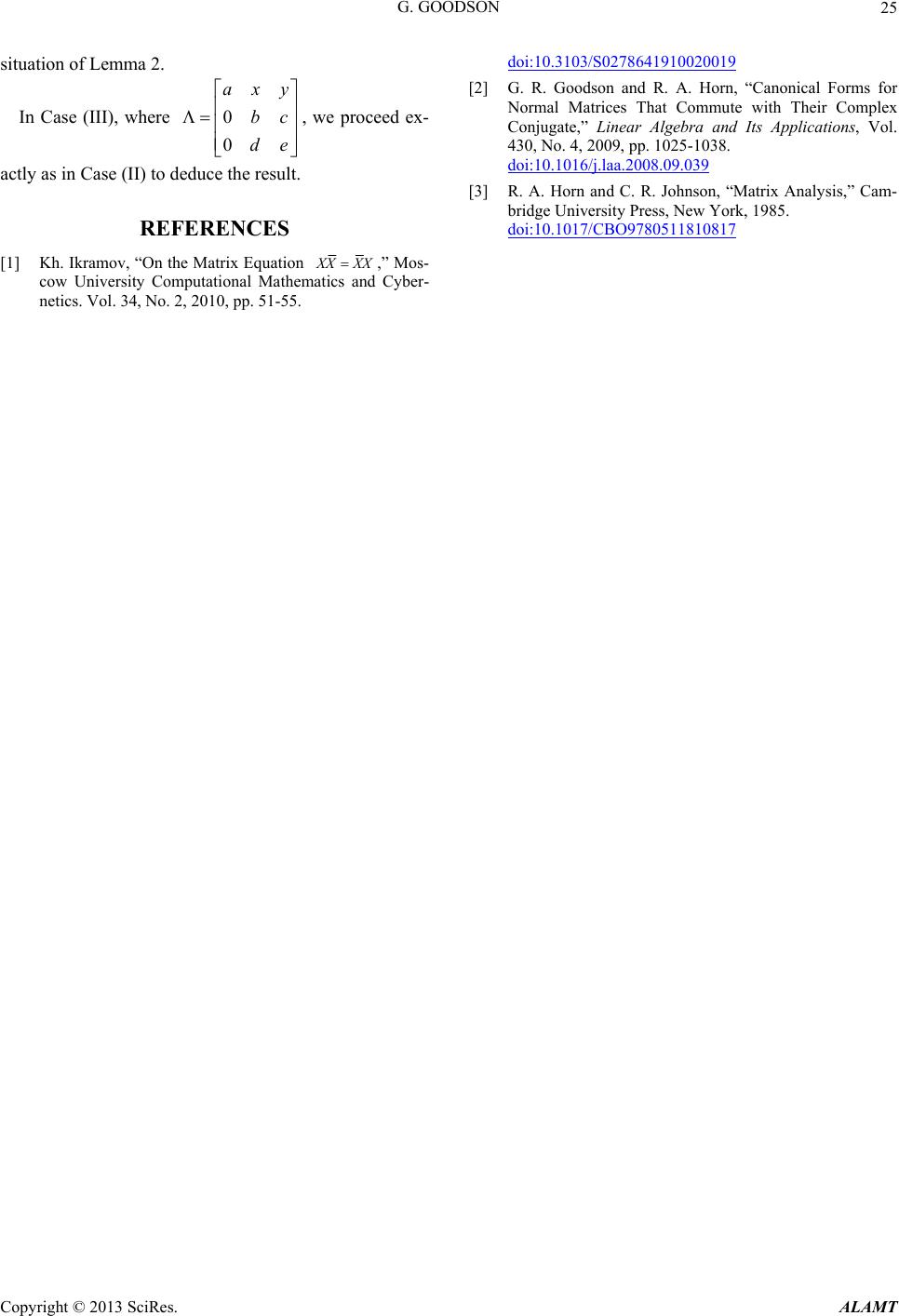Paper Menu >>
Journal Menu >>
 Advances in Linear Algebra & Matrix Theory, 2013, 3, 22-25 http://dx.doi.org/10.4236/alamt.2013.33005 Published Online September 2013 (http://www.scirp.org/journal/alamt) Matrices That Commute with Their Conjugate and Transpose Geoffrey Goodson Towson University, Towson, USA Email: ggoodson@towson.edu Received June 25, 2013; revised July 23, 2013; accepted August 6, 2013 Copyright © 2013 Geoffrey Goodson. This is an open access article distributed under the Creative Commons Attribution License, which permits unrestricted use, distribution, and reproduction in any medium, provided the original work is properly cited. ABSTRACT It is known that if n A M is normal ** A AAA, then A AAA if and only if TT A AAA. This leads to the question: do both A AAA and TT A AAA imply that A is normal? We give an example to show that this is false when , but we show that it is true when 4n2n and 3n . Keywords: Normal Matrix; Matrix Commuting with Its Conjugate and Transpose Introduction and Results Let A be an -by- normal matrix, i.e., n n A is a complex square matrix n A M, with the property that ** A AAA, where *T A A is the conjugate-transpose of A . The Fuglede-Putnam Theorem tells us that if BA A B= for some n, then BM** A BBA. Suppose that A AAA, where A is the conjugate of the matrix A (so we take the complex conjugate of every entry of A ). Then taking the transpos e gives TT TT*T T*T T, A AAAAAAA AAAA from the the Fuglede-Putnam Theorem. In a similar way, we see that if TT A AAA, then A AAA, so these two statements are equivalent when A is normal. The ques- tion arose in [2], whether the conditions TT and A AAA AAAA imply the third condition ** A AAA , so that A is nor- mal. This is false when . In fact, any matrix of the 4n form where , 0 ab cd ab II AI 22 , ab ab Iba ,,,abcd, , and not both zero, has the property that both 0cd cd A AAA 2011). My solution for appeared in the spring 2012 issue, but no solution for the case has ever been given. In this paper, we give the solution for the case 2n3n 3n , and for completeness, we also give the solu- tion for 2n . Specifically we prove: Theorem 1 If n A M , or , then 2n3n A AAA and TT A AAA imply that A is normal. Proof. We need the following preliminary result, which is a direct consequence of Theorem 2.3.6 in [3] (using the fact that for n A M , A BiC where and are real then B C A AAA if and only if BC CB ), and stated explicitly in [1,2]. Theorem 2 Let n A M , , with 3n A AAA . Then there exists a real orthogonal matrix n QM such that is of the form: T QAQ 1 2 3 0 00 000 k A A A, A where each i A , 1ik (for some ) is a 1-by-1 matrix or a 2-by-2 matrix. k and TT A AAA , but A is not normal. In this paper, we prove that if n A M where or 2n3n , then these conditions do imply that A is normal. This result was first pro- posed as a problem by the current author in the Interna- tional Linear Algebra Society journal IMAGE (fall Example 1. Note that if T A QQ , real ortho- gonal, Q A AAA and TT A AAA if and only if and TT . Also note that if T A A and A AAA . then A is normal since * A A in this case. with TT A AAALemma 1 If 2 A M , then A is C opyright © 2013 SciRes. ALAMT  G. GOODSON 23 ei Proof. Suppose that, with ther symmetric or of the form b. a ,, ab a ba ,,,, b Aabcd cd TT A AAA, then 2 b a 2 22 ac bd ac bdcd 22 22 acab cd ab dcbd ac bd. Hence and 22 bc bc,ab cd Case 1. so that A is symmetrir c. Case 2. c, then ab bdab bd o 0 b ab bd. If, then b A is symmetric. If 0b , a Propon 1 If ad nd ab Aba . ositi 2 A M with TT A AAA and A AAA, then A is al. norm Proof. e From th Lemma 1, we have two cases. If ab , ,ab, then Aba A is normal. On the other hand, if A is symmetricwith A AAA, then since * A A in this case, we must have ** A AAA , so A is al. Eample 2. We now look at the case of norm x3 A M . We start with a lemma: Lemma 2 Suppose 3 A M with AA AA, TT A AAA and T A QQ where for somrthoe real ogonal matrix Q 3 M is of one of the two forms: see Equ(1). ation then A is normal. Proof. Case 1: 00 abx bay . Now we require , so that , TT 00 00 00 00 abxa babx bayb ab abay xy xy a b 222 222 2 22 22 222 0 0. abx xyx xya byy xy ab axby ab bxay ax byay bxxy or 0xy A is normal. It follows that , and 0 00 ax y bz c Case 2: If 00 00 0000, 00 00 axyaa axy bzxb xbbz cyzcyzcc then 222 22 2 2 22 222 . axybxyzcy bx yzbzcz cycz c aax ay axxbxy bz ayxybzcyz or 22 0xy22 , Hence x z , , and 22 0yz x z x iy , , y izay cy0y and also , so (giving ac A normal) or diagonal and . Sup- pose ac 0y . so that 0xzCase 2(a). If axbxyzy ba, then x ib az so that and 0. 00 aibaba biab a However, this matrix also has the property that , which gives in Equation (2). It follows from equating the entries in the (1, 2) position 22 22 22ab ab ab ab , or 20ab , ,or0, , 00 00 abx axy baybz ab c ,,,,,, (1)cxyz 222 2222 222 2 2 22 23 02 2(2) 00 0 aia babababa bia babababa b biabab biabab aa 22 2 2 2 2 2223 0 0 a Copyright © 2013 SciRes. ALAMT  G. GOODSON 24 so , and hence is diagonal and ab A is normal. Case 2(b). This is where 0xz , and since we have, so that and this is treated in a si Propositi ax bx xy yab 0, 0 a iabab biab 0a milar way. on 2 If 3 A M h T wit T A AAA and A AAA, then A is normal. Proof. We show that every ca the Lemma 2. From Theorem se reduces to the case of 1, every matrix with T A QQ (Q real orthogonal) can be choso be three forms: (I) , or (III) have dealt within Lemma 2, s Case (II): gives in Equation (3). It follows that 22 , and , so that en t one of the following 0z , (II) 00c 00e 0bc . ax y b 0 axy de abx cdy We Case (I) o consider TT 22 bxc, 22 cyb 22 0xy x iy 0, then . since Case 1. xiy ey bx dyey, biy dy, so bide. Also x ea ives xcy g x eaxcix , so th =cieas the form at ha, so 00 aieiy i y e ea d d e use the faNow wct t h at is gives in E . Thqua- tion (4). On ing 3) position we have: equat entries in the (1, ayydeyeayy deye and simplifying gives yd ayad , so if ad we have yad yad Equating entries in the (2, 3) position gives: , y eady yeyeadyye and this reduces to: yd ayd a , so if ad , yad yad , contradicting the above. We conclu de that ad and is of the form ai aeiy a eay e , 00 i apply Lemma 2. The other possibility is that and we can 0 y x , sothat bc and is either of the form 0 0 00 ab bd e cb, a symmetric matrix (when ), or of the form 00 a y e abiy b (whe cb, since in this n case ad ). Case 2. 0xiy , then gives bx dyey bied gives ciae, and axcyxe , so that has the form ai ediy e .ia edy 00 We procely as in Caduceed exactse 1 to re t 2 o the 222 2 22222 22 (3) abxacb xyxeac abcdaxcy ac bdxycdyeyab cdbdbx dy xeax cyxbydxye 2 2 ye e d 2 2 2 2 2 2 00 (4) 00 adeea iadeidd iaeaideaeadedyeady ye e adee aiadeiddeiay iydeiye iae aideae adedye adyye e eiayiydeiye Copyright © 2013 SciRes. ALAMT  G. GOODSON 25 situation of Lemma 2. In Case (III), where , we proceed ex- actly as in Case (II) to deduce the result. REFERENCES [1] Kh. Ikramov, “On the Matrix Equation 0 0 axy bc de XX XX,” Mos- cow University Computational Mathematics and Cyber- 2, 2010, pp. 51-55. doi:10.3103/S0278641910020019 [2] G. R. Goodson and R. A. Horn, “Canonical Forms for Normal Matrices That Commute with Their Complex Conjugate,” Linear Algebra and Its Applications, Vol. 430, No. 4, 2009, pp. 1025-1038. doi:10.1016/j.laa.2008.09.039 [3] R. A. Horn and C. R. Johnson, “Matrix Analysis,” Cam- bridge University Press, New York, 1985. doi:10.1017/CBO9780511810817 netics. Vol. 34, No. Copyright © 2013 SciRes. ALAMT |

